The Barbituric Acid Market is estimated to be valued at USD 22.7 million in 2025 and is projected to reach USD 35.5 million by 2035, registering a compound annual growth rate (CAGR) of 4.6% over the forecast period.
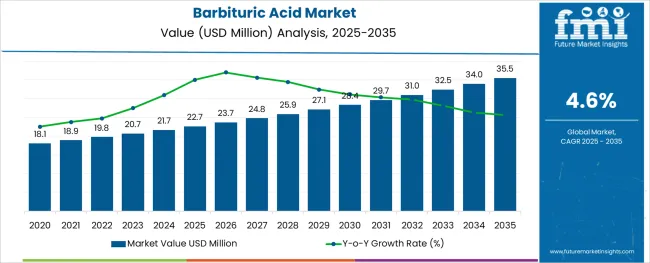
The barbituric acid market is growing steadily due to its critical role as a chemical intermediate in pharmaceutical manufacturing. The demand is driven by the production of various drugs and compounds that rely on barbituric acid as a foundational ingredient. Increasing investments in pharmaceutical research and development, along with expansions in drug production capacities, have contributed to the growth.
The pharmaceutical industry’s focus on high-purity raw materials to meet stringent quality and regulatory standards has further supported market demand. Moreover, the expanding pharmaceutical sector in emerging markets and rising healthcare expenditures globally have amplified the requirement for barbituric acid.
Technological advancements in synthesis and purification processes have enhanced product quality, making high purity grades more accessible. The market is expected to grow as pharmaceutical intermediates continue to play a pivotal role in drug formulation. Segment growth is expected to be driven by the high purity grade 99% (pharmaceutical grade), pharmaceutical intermediate application, and the pharmaceutical end-use industry.
The market is segmented by Grade, Application, and End-Use Industry and region. By Grade, the market is divided into High Purity Grade 99% (Pharmaceutical Grade) and Regular grade 98% (Industrial Grade). In terms of Application, the market is classified into Pharmaceutical intermediate, Dye intermediate, and Nutritional supplement.
Based on End-Use Industry, the market is segmented into Pharmaceutical, Plastics, Textiles, Polymers, and Others. Regionally, the market is classified into North America, Latin America, Western Europe, Eastern Europe, Balkan & Baltic Countries, Russia & Belarus, Central Asia, East Asia, South Asia & Pacific, and the Middle East & Africa.
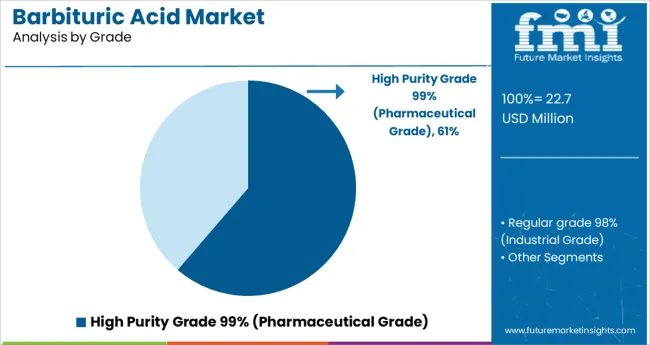
The high purity grade 99% segment is projected to hold 61.3% of the barbituric acid market revenue in 2025, establishing it as the dominant grade segment. This segment’s growth is driven by the pharmaceutical industry’s strict requirements for purity to ensure drug safety and efficacy. High purity barbituric acid is essential in synthesizing active pharmaceutical ingredients and intermediates where impurities can affect drug performance.
Manufacturers have focused on improving purification methods to meet regulatory standards and provide consistent quality. The increasing production of high-value pharmaceuticals that rely on this grade has also contributed to its market dominance.
As regulatory bodies maintain rigorous quality controls, the demand for high purity barbituric acid is expected to remain strong.
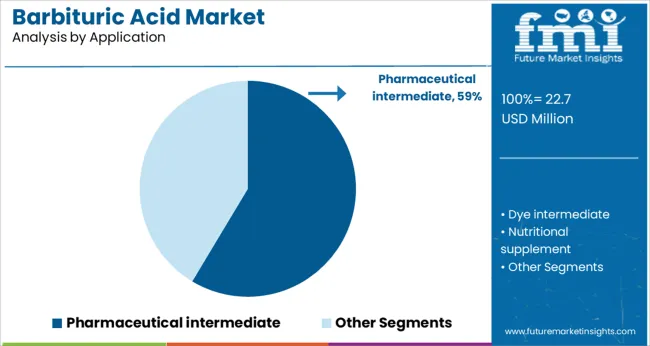
The pharmaceutical intermediate segment is forecasted to account for 58.6% of the market revenue in 2025, maintaining its position as the leading application. Barbituric acid is widely used as a building block in the synthesis of various pharmaceutical compounds. Its role in creating sedatives, anesthetics, and other therapeutic agents has kept demand steady.
Industry trends toward developing new formulations and drug delivery systems continue to support its use as a key intermediate. Additionally, increased emphasis on efficient drug development pipelines has further reinforced the importance of high-quality pharmaceutical intermediates.
The growing pharmaceutical manufacturing base in emerging economies has expanded the market for barbituric acid in this application. The pharmaceutical intermediate segment is expected to sustain growth as drug innovation and production intensify.
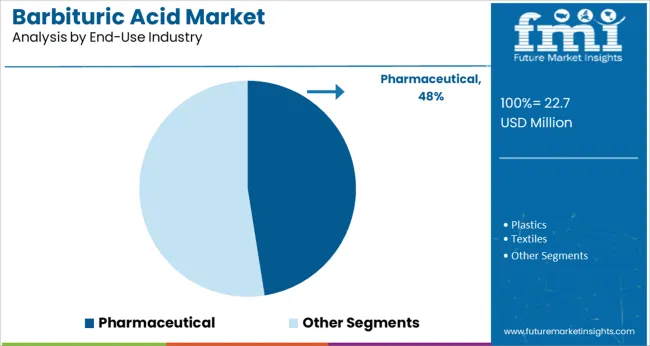
The pharmaceutical end-use industry segment is projected to contribute 47.5% of the barbituric acid market revenue in 2025, securing its position as the primary industry consumer. This growth is driven by the pharmaceutical sector’s continuous expansion and demand for reliable chemical intermediates in drug production. The development of new medications and generics, along with increased focus on quality control and regulatory compliance, has elevated the consumption of barbituric acid.
Pharmaceutical manufacturers prioritize sourcing high-purity raw materials to meet safety and efficacy standards. Furthermore, rising healthcare needs and drug consumption globally have supported steady growth in the pharmaceutical industry’s usage of barbituric acid.
As pharmaceutical production scales up, the demand from this end-use industry is expected to remain robust.
Over the years, rising prevalence of various diseases and increasing consumer healthcare spending have triggered the growth of pharmaceuticals industry and this trend is likely to further escalate during the forecast period on account of increasing healthcare awareness among people. Driven by this demand for barbituric acid is slated to grow at a considerable pace.
Barbituric acid itself is not pharmaceutically active. However, it is being used as a raw material used for making a wide range of barbiturates. Rising prevalence of diseases like insomnia and seizures along with growing usage of barbiturate drugs as hypnotics, anticonvulsants, sedatives, anesthetics and most importantly sleeping pills is projected to boost the growth of barbituric acid market during the forecast period.
Globally there are millions of people who suffer from insomnia, anxiety and several other sleeping disorders. For instance, according to the American Sleep Apnea Association, around 50 million Americans already suffer from over 80 different sleep disorders while another 20 to 30 million suffer intermittent sleep problems each year. This is creating huge demand for barbiturates which will eventually foster the growth of barbituric acid market in the future
Similarly, rising usage of barbituric acid for laboratory synthesis of riboflavin (vitamin B2) and minoxidil will create lucrative growth opportunities for the leading barbituric acid manufacturing companies during the forthcoming years.
In addition to this, growing adoption of barbituric acid as dye intermediate used in textile industry will further expand the barbituric acid market size in the future.
Despite multiple applications of barbituric acid, there are certain factors that are likely to restrain the growth of barbituric acid market. One such factor is the presence of stringent regulations pertaining to the manufacturing of barbiturates drugs.
As barbiturates have numerous side effects, they are being strictly monitored by the Drug Abuse Prevention and Control Act. This is negatively impacting the market growth to some extent.
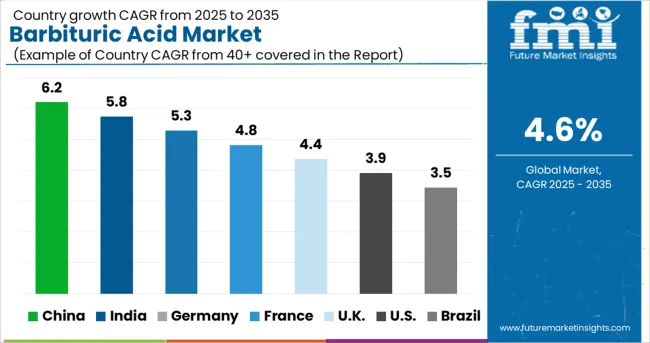
FMI predicts the Asia Pacific market to retain its dominant position during the forecast period, owing to the high production and consumption rates of barbituric acid, large presence of barbituric acid manufacturing companies, and expanding plastics and pharmaceutical industries.
In recent years, there has been a sharp rise in sleeping disorders across highly populated nations like China and India. In order to manage and treat these sleeping disorders people use drugs like barbiturates. This is providing a major impetus to the growth of Asia pacific barbituric acid market.
Similarly, increasing usage of barbituric acid in health supplements will further push the demand for barbituric acid in the region during the assessment period.
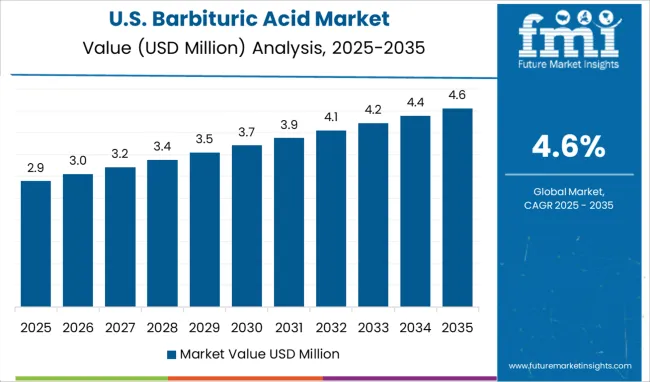
As per FMI, demand for barbituric acid is projected to grow at a rapid pace in the North America Market, owing to the rapid adoption in pharmaceutical industry, rising prevalence of diseases like sleep disorders, increasing healthcare spending, and strong presence of leading barbituric acid manufacturing companies.
Barbituric acid sales are especially rising across the USA due to increasing prevalence of insomnia, growing production and consumption of barbiturates, and presence of some of the world’s leading pharmaceutical companies.
According to the American Sleep Apnea Association, chronic insomnia affects around 10% of Americans and this number is further expected to increase in the upcoming years. In order to treat this condition, people consume drugs like barbiturates on large scales. This is fostering the growth of barbituric acid market in the region.
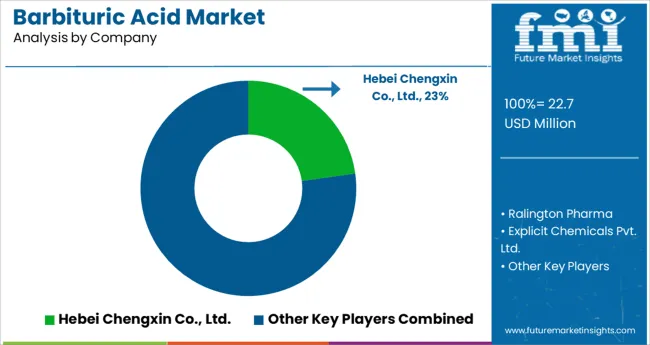
Some of the key manufacturers of barbituric acid are Ralington Pharma, Zhengzhou Lifeng Chemical Co., Ltd., Explicit chemicals pvt. Ltd., Hebei Chengxin Co., Ltd., Danopharm Chemicals Pvt. Ltd., CDH Druh House (P) Ltd., Sparchem, Hunan HongQiang Chem Technology Development Co., Ltd., GFS Chemicals Inc, and Hem Corporation.
These key barbituric acid manufacturing companies are adopting strategies such as partnerships, collaborations, mergers, acquisitions, and establishment of new production facilities to gain a competitive edge in the global barbituric acid market. Furthermore, they are investing in research and development to explore new application areas of barbituric acid.
| Report Attribute | Details |
|---|---|
| Growth Rate | CAGR of 4.6% from 2025 to 2035 |
| Market Estimated Value (2025) | USD 22.7 million |
| Projected Market Size (2035) | USD 35.5 million |
| Base Year for Estimation | 2024 |
| Historical Data | 2020 to 2024 |
| Forecast Period | 2025 to 2035 |
| Quantitative Units | Revenue in million and CAGR from 2025 to 2035 |
| Report Coverage | Revenue Forecast, Volume Forecast, Company Ranking, Competitive Landscape, Growth Factors, Trends and Pricing Analysis |
| Segments Covered | Grade, Application, End-Use Industry, Region |
| Regions Covered | North America; Latin America; Western Europe; Eastern Europe; APEJ; Japan; Middle East and Africa |
| Key Countries Profiled | USA, Canada, Brazil, Argentina, Germany, UK, France, Spain, Italy, Nordics, BENELUX, Australia & New Zealand, China, India, ASEAN, GCC, South Africa |
| Key Companies Profiled | Ralington Pharma; Zhengzhou Lifeng Chemical Co., Ltd.; Explicit chemicals pvt. Ltd.; Hebei Chengxin Co., Ltd.; Danopharm Chemicals Pvt. Ltd.; CDH Druh House (P) Ltd.; Sparchem; Hunan HongQiang Chem Technology ; Development Co., Ltd.; GFS Chemicals Inc; Hem Corporation |
| Customization | Available Upon Request |
The global barbituric acid market is estimated to be valued at USD 22.7 million in 2025.
It is projected to reach USD 35.5 million by 2035.
The market is expected to grow at a 4.6% CAGR between 2025 and 2035.
The key product types are high purity grade 99% (pharmaceutical grade) and regular grade 98% (industrial grade).
pharmaceutical intermediate segment is expected to dominate with a 58.6% industry share in 2025.






Full Research Suite comprises of:
Market outlook & trends analysis
Interviews & case studies
Strategic recommendations
Vendor profiles & capabilities analysis
5-year forecasts
8 regions and 60+ country-level data splits
Market segment data splits
12 months of continuous data updates
DELIVERED AS:
PDF EXCEL ONLINE
Acid Resistant Pipe Market Forecast and Outlook 2025 to 2035
Acid Coil Cleaner Market Size and Share Forecast Outlook 2025 to 2035
Acid Filling and Leveling Machine Market Size and Share Forecast Outlook 2025 to 2035
Acid Chlorides Market Size and Share Forecast Outlook 2025 to 2035
Acid-Sensitive APIs Market Analysis - Size, Share, and Forecast Outlook 2025 to 2035
Acidified Whey Protein Market Analysis - Size, Share & Trends 2025 to 2035
Acid Dyes Market Growth - Trends & Forecast 2025 to 2035
Acidity Regulator Market Growth - Trends & Forecast 2025 to 2035
Acid Proof Lining Market Trends 2025 to 2035
Acid Citrate Dextrose Tube Market Trends – Growth & Industry Outlook 2024-2034
Acid Orange Market
Antacids Market Analysis – Size, Trends & Forecast 2025 to 2035
Lead Acid Battery Market Size and Share Forecast Outlook 2025 to 2035
Lead Acid Battery Recycling Market Size and Share Forecast Outlook 2025 to 2035
Feed Acidifier Market Analysis Size Share and Forecast Outlook 2025 to 2035
Food Acidulants Market Growth - Key Trends, Size & Forecast 2024 to 2034
Boric Acid Market Forecast and Outlook 2025 to 2035
Folic Acid Market Size and Share Forecast Outlook 2025 to 2035
Oleic Acid Market Size and Share Forecast Outlook 2025 to 2035
Dimer Acid-based (DABa) Polyamide Resin Market Size and Share Forecast Outlook 2025 to 2035

Thank you!
You will receive an email from our Business Development Manager. Please be sure to check your SPAM/JUNK folder too.
Chat With
MaRIA